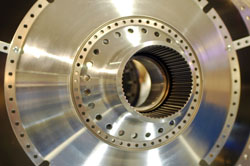Simulating manufacture to reduce part distortion
Manufacturing processes can often induce residual stress (RS) in components that leads to part distortion (PD). PD is an expensive issue for the aerospace industry where millions of euros are spent each year in an attempt to avoid or remedy problems. A group of scientists sought to fill the existing knowledge gap regarding the relationship of process parameters on RS and consequently how RS affects PD. With EU-funding of the project ‘A concurrent approach to manufacturing induced part distortion in aerospace components’ (Compact), European researchers investigated design in the context of RS. Knowledge gained would enable optimisation of manufacturing to produce complex-shaped light-weight alloys resulting in reductions in manufacturing and operating costs. Throughout the project at each step, researchers took investigative and experimental data and used it to form modules to be integrated into a knowledge-based advisory and decision-support system. Scientists investigated novel strategies for reducing the impact of RS on PD by determining highly influential parameters (for example, so-called quenching and stress-relieving). RS measurement was greatly improved by development of a new ultrasound technique. They also studied the effects of three different treatment processes on RS with the goal of developing a distortion correction process to ameliorate RS while maintaining mechanical performance. Finite-element models (FEMs) of materials and processes were combined to form a unified modelling environment and case studies were evaluated to derive a framework for design focused on combating PD. As a result, two distortion prediction tools were created, one simple and one incorporating a more in-depth analysis. Exploitation of the PD simulation environment should be widespread given the relevance of reducing PD for numerous industries.







